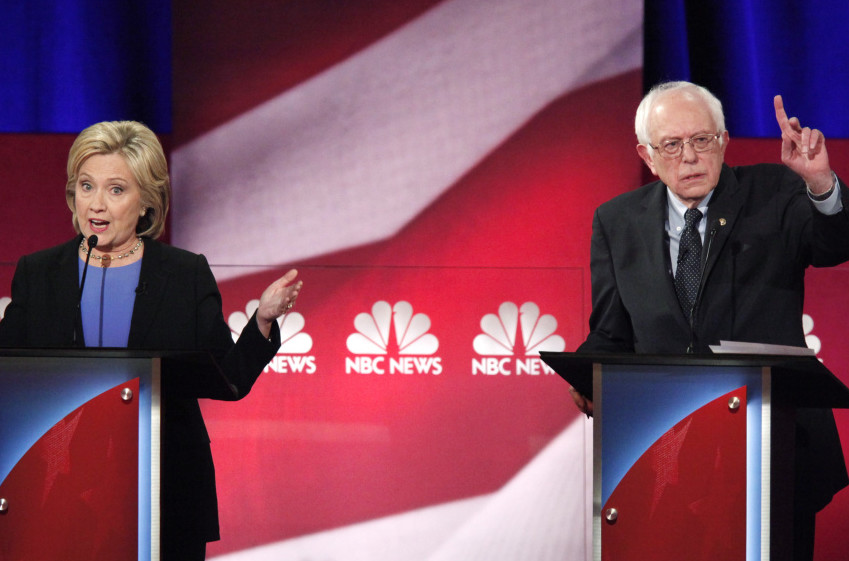Recall this 2008 storyline: Hillary Clinton enters the presidential campaign as the Democratic front-runner, runs into an inspirational candidate who generates big crowds and enthusiasm. And she winds up in a dogfight in Iowa.
Sound familiar? With just days left before Iowa’s lead-off caucuses, Clinton finds herself in a heated contest against insurgent Bernie Sanders reminiscent of her 2008 face-off with then-Sen. Barack Obama. The Vermont senator has soared to a nip-and-tuck race in Iowa and holds an advantage in New Hampshire, putting Clinton back on the brink in her second presidential bid.
Clinton lost Iowa in 2008, a setback that she never fully recovered from against Obama. This time she hopes a larger field organization in Iowa and an escalation of her critiques of Sanders’ record and message might undercut his momentum.
Yet there may be a silver lining for Clinton’s 2016 campaign: Unlike Obama, Sanders is a self-described “democratic socialist” and has done little to expand his support beyond white liberals who populate the first two presidential contests. Clinton has locked down nearly all of the establishment support – governors, members of Congress and Democratic leaders – who can help her in a lengthy primary.
SOUTHERN STRATEGY
And, for now, the former secretary of state has an edge in a series of Southern-heavy primaries and caucuses after Iowa and New Hampshire. The question is whether that edge vanishes if Sanders defeats Clinton in the first two contests, a distinct possibility.
“Bernie’s appeal is powerful and it resonates with a certain lane of the Democratic electorate for sure, young voters, independent voters,” said Steve McMahon, a Democratic strategist who advised Howard Dean in 2004. “But it’s ultimately not a winning general election message, it’s a protest message.”
Clinton led in Iowa throughout the fall and into December but polls released this month have depicted a much tighter race against Sanders. At campaign stops, Clinton has ramped up her criticism of Sanders, questioning the practicality of his agenda to provide universal health care, his voting record on gun control and his foreign policy credentials.
Her campaign has seized upon Sanders’ suggestions that the U.S. should normalize relations with Iran, saying it makes him an outlier compared with Obama and Clinton. Driving the foreign policy message, Clinton released a new ad on Friday, in which the narrator says, “She’s the one leader who has what it takes to get every part of the job done.”
Though less provocative, it offers parallels to Clinton’s “3 a.m.” ad against Obama, which asked voters who they would want to answer the early morning phone call to respond to a global challenge.
SHADES OF OBAMA IN SANDERS
Sanders, like Obama, has sought to offer a more uplifting, aspirational message. His latest ad, “America,” shows off his massive rallies and a genial image of the 74-year-old lawmaker to the tune of the famous 1968 song by Simon and Garfunkel.
It presents a window into how Sanders has tapped into a key part of the Obama coalition: white liberal voters and young voters. Both were critical in Obama’s Iowa victory in 2008.
But one major question entering Iowa is whether there will be enough of them. In 2008, Obama fueled a massive turnout in Iowa – 240,000 people participated, compared to about 125,000 in 2004 – and few expect crowds anywhere near that 2008 size.
The 2008 Democratic field included eight major candidates, driving up turnout. Other than Clinton and Sanders, former Maryland Gov. Martin O’Malley is the only other major Democratic candidate.
Copy the Story LinkSend questions/comments to the editors.



Success. Please wait for the page to reload. If the page does not reload within 5 seconds, please refresh the page.
Enter your email and password to access comments.
Hi, to comment on stories you must . This profile is in addition to your subscription and website login.
Already have a commenting profile? .
Invalid username/password.
Please check your email to confirm and complete your registration.
Only subscribers are eligible to post comments. Please subscribe or login first for digital access. Here’s why.
Use the form below to reset your password. When you've submitted your account email, we will send an email with a reset code.